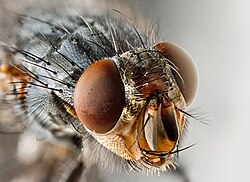| Cyclorrhapha | |
|---|---|
 | |
| Musca domestica | |
| Scientific classification | |
| Domain: | Eukaryota |
| Kingdom: | Animalia |
| Phylum: | Arthropoda |
| Class: | Insecta |
| Order: | Diptera |
| Suborder: | Brachycera |
| Infraorder: | Muscomorpha |
| Clade: | Eremoneura |
| (unranked): | Cyclorrhapha |
| Sections | |
Cyclorrhapha is an unranked taxon within the infraorder Muscomorpha. They are called "Cyclorrhapha" ('circular-seamed flies') [1] with reference to the circular aperture through which the adult escapes the puparium. [2] This is a circumscriptional name that has significant historical familiarity, but in the present classification, this name is synonymous with the more recent "Muscomorpha". [3]
Cyclorrhapha underwent major adaptive radiation that led to the creation of over 72 000 species. These species share multiple attributes such as the 360-degree rotation of the male terminalia. [4]
Cyclorrhapha exhibits significant morphological and molecular diversity, including notable changes in anterior egg development, as exemplified by the role of the exuperantia (exu) gene in Anastrepha fraterculus, a species of great agricultural importance. [5] Additionally, phylogenetic analyses suggest that the larval structures of Cyclorrhapha have evolved in response to varying food consistencies, reflecting their ecological adaptations. [6]